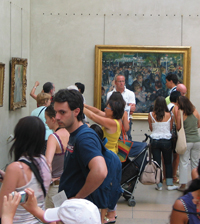Cover your assets
Benjamin Futerman and Tim Maxwell consider the impact of damage to works of art and how to protect artwork financially, physically and legally

The Van Abbemuseum in Eindhoven is the owner of a 1943 Picasso painting, ‘Buste de Femme’. It is the Dutch institution’s most valuable artwork, and is valued at $7m. For over a year, the museum has been in negotiations with another institution about a possible loan of the painting. This is far longer that the normal six-month negotiation period for such international and inter-institutional loans. The difference being that the receiving body is the one-year-old International Academy of Art Palestine, in Ramallah. Given the volatility of the region, security concerns and the relative inexperience of the academy in displaying such prestigious works, it is understandable that the Dutch should be cautious.
When the Saatchi fire destroyed ‘Hell’ by the Chapman brothers, Jake infamously and mischievously declared: “We’ll make it again, it’s only art.” Of course, the Van Abbemuseum, and indeed any lending institution, is unlikely to see it like that. It isn’t ‘only’ art; it’s a highly valuable income-generating asset. There is always a risk that art may be damaged when it is loaned, whether it be to a small gallery in a troubled region or to one of the most prestigious, experienced and metropolitan galleries in the world. The issue is how to protect the artwork financially, physically and legally.
As with so much legal advice, the key is to anticipate problems and draw up a robust document in the form of a loan agreement. Once an institution has identified the work it wishes to borrow, negotiations can begin on the practicalities. The agreement should specify how and where the work is to be hung. Temperature, light and moisture are all obvious concerns. From a practical perspective the artwork should be inspected before it leaves the loaner and again when it arrives with the borrower, to ensure any damage can be properly attributed. There should also be regular inspections during an exhibition so that developing problems are quickly appreciated.
Of course, things do still go wrong. In 2006, the Pompidou Centre in Paris inadvertently destroyed two artworks by American artists. One was incorrectly hung and dropped to the floor. In that case, the museum paid $28,000 in damages to the artist, Peter Alexander. There was also an offer to commission a replacement work by the artist. However, the Pompidou’s solution is not always available: the Abbemusem cannot commission a new Picasso. Therefore, a more common means of rectifying a damage problem is to make an insurance claim which pays out to the owner of the work. Good legal advice will focus on trying to protect a loaning party’s property in the event that the unfortunate happens. Most often this means a clearly defined insurable value for the work and a binding commitment that the borrower uses a reputable insurer. The well-drafted loan agreement will make the borrower liable for all damage caused to the artwork. This is vital to ensure that the loaning party is satisfied they have minimised their exposure to financial losses because of the lending. This may be a greater imperative where trustees are involved who may wish to seek advice on the liability implications of any loan.
However, there is a current debate that perhaps museums are paying too much for insurance cover that they will almost certainly not use. Experts, the Collections Mobility 2.0 Project, conducted research that showed in a five-year period of loans between eighteen European institutions there were only seven instances of damage and all of them minor. There is an incentive for museums to avoid damaging art as they are unlikely to obtain loans in the future. Furthermore, it is being reported that insurance costs could be better spent on improving security at galleries. In any event, insurance costs should be brought below the current rate of 15% of an exhibition’s budget – which is far from uncommon for the major institutions. Perhaps galleries should rely on their improved security and any viable governmental compensation scheme that is available to them?
The problem with such thinking, from a legal perspective, is that whilst a cost/benefit analysis should be carried out, damage or destruction to some art can be enormously costly. If the Buste de Femme is damaged beyond repair whilst being loaned to the International Academy of Art, the $7m compensation payment would, in all likelihood, bankrupt the fledgling Academy. An insurance premium, expensive though it might be in itself, is by far the more prudent option. Without it, the bigger, more financially valuable loans may not reach such a wide audience and museums may be unwilling to lend on this basis. The lack of insurance would also need to be reconciled with the loaning institution’s internal obligations.
The benefits of inter-organisational lending are numerous. They bring the artist to a wider audience and increase common cultural currency. These loans bring lucrative financial benefits to the organisations involved. Clearly though, no matter how diligent a gallery is, accidents can and will happen. And because art is rarely, if ever, ‘only art’, a comprehensive and robust loan agreement is a necessity to protect and encourage future lending.
Join the Discussion
You must be logged in to post a comment.